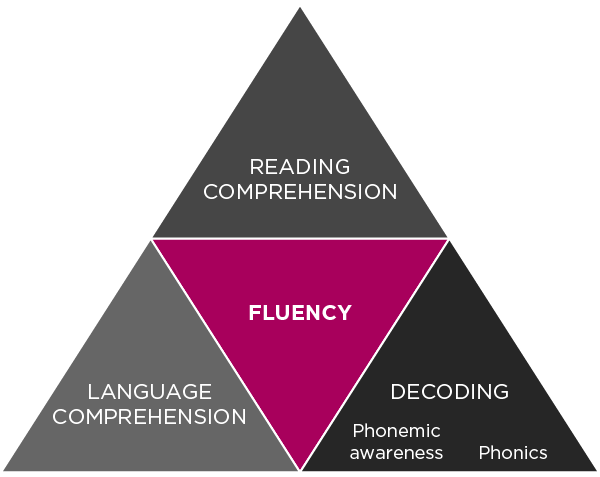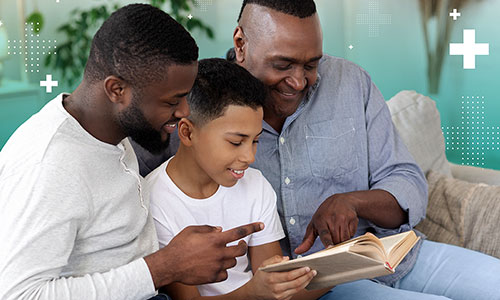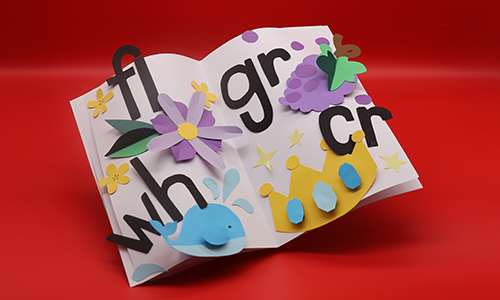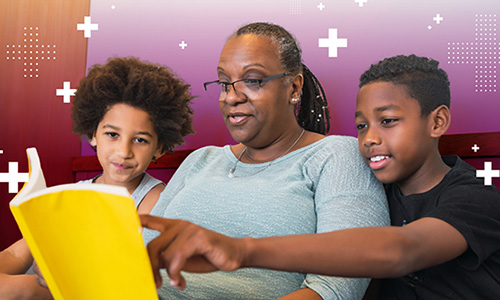
You know his voice. It’s deep, soothing, trustworthy. Fans have described it as “running your hand across expensive velvet” or “drinking a rich creamy coffee with your ears.”
His voice is everywhere: movies, commercials, audiobooks, video games, even traffic apps. But what is it about Morgan Freeman that makes him such an in-demand narrator, one who captivates our ears and hearts? Why would I gladly listen to him recite lyrics to a Justin Bieber song? (The Internet is a strange place.) Well, part of his magic as a narrator begins with his reading fluency skills.
What is reading fluency?
As children gain skills in reading individual words, they begin to work with connected text: sentences, paragraphs, and pages of text. As adult readers, we’re mostly reading silently in our heads. But when children learn to read, they read out loud. This allows teachers and families to observe the three important ingredients of reading fluency: rate, accuracy, and expression.
Let’s look at each of these ingredients in action with Morgan Freeman. When he narrates a film, he reads his lines at a speed, or rate, that is comfortable for the audience to follow along with: not too fast, not too slow, but at just the right pace based on what he’s reading. His rate is also smooth, not choppy. He pronounces the words accurately. He shows expression by pausing when making an important point or raising the pitch of his voice when asking a question. Of course, he is a paid actor who gets to read a script in advance, but still. His expert reading fluency is one of the reasons for his success as a professional narrator.
When a child is reading fluently, they are able to pronounce the words accurately with relative speed. However, it’s important to note that reading words correctly and quickly doesn’t always mean children have understood what they’ve read. We’ve all probably experienced listening to a child—or even an adult—read a text at a fast rate but with a monotone voice. It’s not a pleasant experience. (Remember this funny but headache-causing commercial from the ’80s?) It’s also a sign that a child may not be understanding what they are reading.
We want children to read with an appropriate rate, accuracy, and expression, just like Morgan Freeman. If a child is reading so fast that they are not pausing at appropriate places or changing the tone of their voice, then they are likely not understanding what they are reading. This is why expression is key. Understanding appropriate phrasing and punctuation supports meaning making.
Why is fluency important for reading?
Fluency is really important for reading because children who read fluently recognize more words automatically and spend less time sounding them out (also called decoding). This frees up their brain to focus on making meaning of the words they are reading. They are able to more quickly draw on their vocabulary and background knowledge, which means reading comprehension can occur more easily. Indeed, reading fluency strongly predicts reading comprehension.
In the pyramid graphic below, you can think of fluency, the center triangle, as the bridge that helps readers combine their language comprehension (bottom left triangle) with their decoding skills (bottom right triangle) to achieve reading comprehension (top triangle).
 There is huge and important growth in reading fluency for kids in first and second grade. A typical reader progresses from reading aloud about 30 words correct per minute in the middle of grade 1 to reading aloud about 100 words correct per minute by the end of grade 2. This growth opens the doors for readers to comprehend and explore a whole new world of ideas!
There is huge and important growth in reading fluency for kids in first and second grade. A typical reader progresses from reading aloud about 30 words correct per minute in the middle of grade 1 to reading aloud about 100 words correct per minute by the end of grade 2. This growth opens the doors for readers to comprehend and explore a whole new world of ideas!
Children who encounter difficulties with fluency may avoid opportunities in class where they are asked to read aloud out of fear of embarrassment or feelings of frustration. They might show little interest in reading books for pleasure. When children don’t participate in reading activities, they miss important chances to further develop their reading skills. It’s important that students are given time and support to work on their reading fluency skills.
What can you do to help support your child’s reading fluency at home?
There’s a lot you can do to help your child strengthen their reading skills. Here are a few suggestions for things to try that will support their fluency. They are great for kids of all ages.
1. Listen to your child read aloud
The first step in helping your child with fluency is to listen to them read aloud a page or so of grade-appropriate text. Listening to your child read will help you better understand where they might need the most support.
Fluency work typically begins around the middle of first grade. Children have begun learning to decode individual words and are now reading those words in connected sentences. As a result, they can begin practicing reading with accuracy, rate, and expression. Children continue to develop their fluency skills in grades 2–12 as they encounter texts with longer sentences and more challenging vocabulary.
2. Start a family band
Just kidding. Well, sort of.
One fun way to help your child develop reading fluency is to do something called choral reading. Using that strategy, you and your child (and whoever else wants to join in!) read a story out loud together and at the same rate. It might sound odd, but it’s a common classroom practice. The video “Choral reading” on YouTube will give you a good feel for what it looks like. (It’s directed at teachers, but stick with it. Hop ahead to minute 3:33 if you’re pressed for time.)
Choral reading is a great exercise to repeat more than once. Children benefit from repeated reads of the same text. We all benefit from practice, and repeated readings give children more opportunities to hone their accuracy, rate, and expression. You can bet that as a professional narrator, Morgan Freeman reads and rereads his script so he, too, can practice his fluency before speaking into a microphone.
Repeated reads also allow children to dig deeper into the texts and strengthen their understanding of what they are reading. If you’ve ever had to reread directions when putting together a piece of furniture, then you know the benefit that a second (or maybe even third) read can bring to a situation. You catch details that you didn’t notice the first time.
3. Model, model, model
Read aloud to your child and model fluent reading with appropriate rate, accuracy, and expression. This can be from a picture book, a chapter book, an interesting article in a newspaper or magazine, or somewhere else altogether. For longer texts, don’t worry. You don’t have to model fluency with the entire thing! You can use chunks of 100 words or so.
You can even pair books with their audio versions so your child can follow along with an expert fluent reader. Storyline Online and PBS Kids Read-Alongs are two free online resources that feature celebrities reading children’s books aloud.
For older readers, talk to your school or local librarian about pairing a printed version of a book with its audio version. There are also several websites and apps that offer free audiobooks.
4. Practice, practice, practice
Children learn by doing. After listening to you read aloud a section of text, your child can practice by trying to read it aloud to you.
If your child struggles, try not to jump in right away to help them. A valuable model to remember is pause-prompt-praise. Pause to give them time to try to determine how to pronounce a word or to self-correct an error. If your child is stuck, prompt them by offering some suggestions to get back on track. (One helpful tip for fluency practice is for children to physically track the words as they read. This may be with their finger or even a paintbrush.) Then comes the easiest part: offering praise. Let your child know when they’ve demonstrated strong effort and success.
5. Focus on a topic or text they love
Don’t make reading a task they dread. You want your child to enjoy reading! Find books on topics they love. Your local librarian is sure to be eager to help you find plenty of options.
If your child isn’t into anything in particular right now, reread some of their favorites. (Remember, repetition is good for kids who are learning to read.) Ask them what they love about those books, and consider trying to find others that touch on similar themes or have the same author or illustrator.
6. Stay connected with their teacher
If you notice your child is struggling to read with fluency once they begin to read longer texts, talk to their teacher to learn what they are noticing at school. Ask them if additional support or evaluation is warranted.
If your child has excellent reading fluency with longer books, they might be ready for more challenging texts. Staying in touch with your child’s teacher will help you feel confident you’re meeting your child where they are.
Fluency is fundamental
While only a lucky few like Morgan Freeman will make major bucks for their stellar narration skills, we all benefit from strong reading fluency. It helps us spend less time sounding out individual words and more time making meaning of the message and ideas of the author.
Remember: the aim of reading isn’t to read as many words correctly per minute as possible. The goal is to be able to understand more and more complex texts as we become stronger readers.






